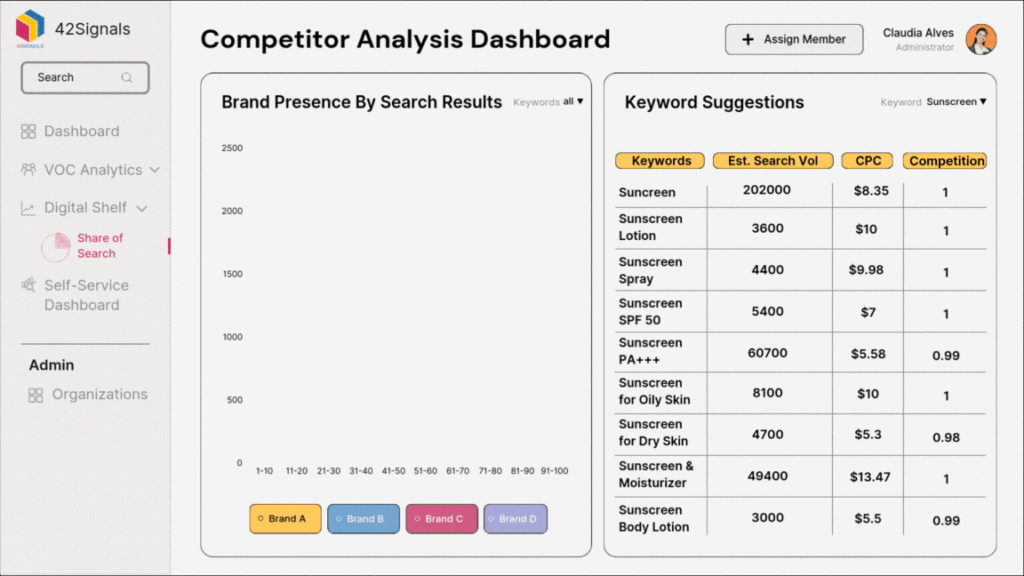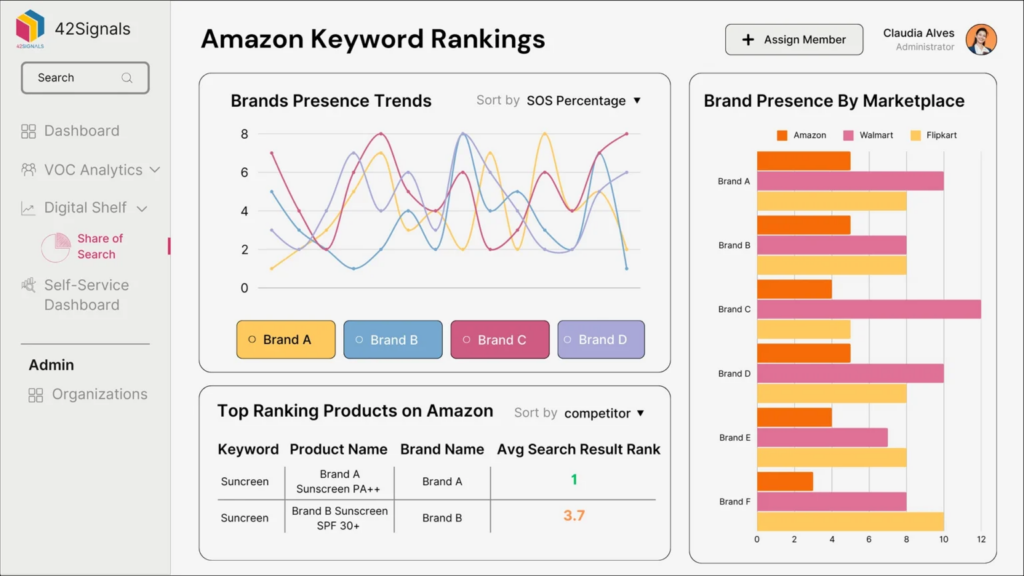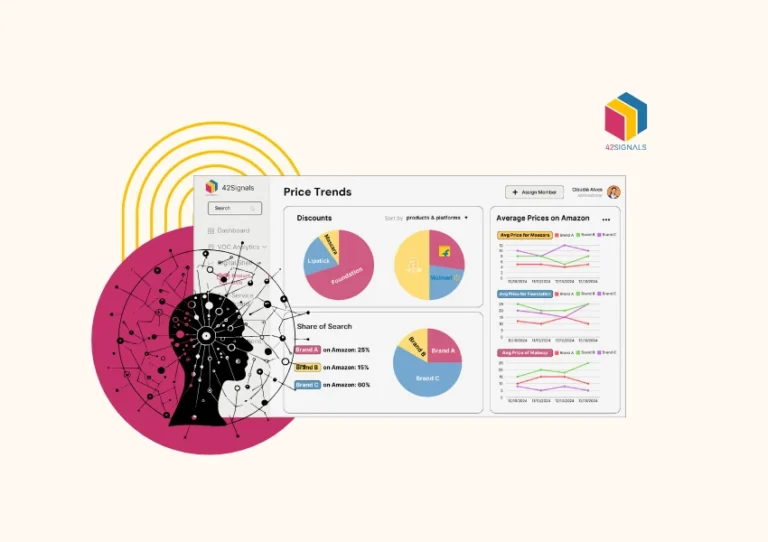If you are selling on Amazon, you are battling it out with several other brands pushing similar products in any given category. Pricing is what usually differentiates products and compels the customer to buy the item. Amazon price tracking helps brands understand how to price items, stand out, and sell products faster.
Why Amazon Price Tracking is Non-Negotiable

Image Source: AMZ Scout
Amazon’s algorithm rewards competitive pricing. Products priced too high lose visibility; those priced too low erode margins. Consider these stats:
- 80% of Amazon shoppers choose products priced within 5% of the lowest offer.
- Price changes can impact sales velocity by up to 300% within 24 hours.
But pricing isn’t just about undercutting rivals. It’s about balancing profitability with demand signals, competitor moves, and customer behavior. Here’s how to do it right with Amazon price tracking.
Step 1: Deploy Amazon Price Alerts to Stay Agile
Amazon price alerts notify you the moment competitors adjust their pricing. Tools like Keepa, SellerApp, or specialized platforms like 42Signals let you:

- Track price changes for specific ASINs.
- Set triggers for when a rival’s price drops below a threshold.
- Receive alerts via email, SMS, or Telegram alerts for instant action.
Case Study:
A home decor seller used Telegram alerts to monitor a competitor’s LED lamp. When the rival slashed prices by 15% during a flash sale, the seller matched the discount but added a “2-pack bundle” at a 5% premium. Result? They retained the Buy Box and boosted the average order value.
Pro Tip:
Prioritize monitoring competitors who consistently win the Buy Box. Use a competitor analysis dashboard to identify these players in your niche.
Step 2: Use a Competitor Analysis Dashboard for Pricing Warfare

A competitor analysis dashboard aggregates data on rivals’ prices, inventory levels, and sales velocity. Tools like Jungle Scout or Helium 10 provide insights such as:
- Historical price trends (e.g., a competitor lowers prices every Friday).
- Stock-out patterns (attack when they’re low on inventory).
- MAP (Minimum Advertised Price) violations to report to brands.
How to Act on It:
- Dynamic Repricing: Tools like Informed.co adjust prices in real time based on predefined rules (e.g., stay 2% below Competitor X).
- Bait-and-Switch Defense: If a competitor lists a product at a loss to lure customers, use your dashboard to spot the tactic and avoid a race to the bottom.
Example:
A skincare brand noticed a rival consistently undercutting them by 10% at month-end (likely to meet sales quotas). They scheduled automated price drops 48 hours earlier, stealing the Buy Box during peak traffic.
Step 3: Optimize Beyond Price with Digital Shelf Analytics
Digital shelf analytics ensure your product’s entire presentation—images, titles, reviews—supports your pricing strategy.

Tools like Profitero or Stackline help you:
- Audit product pages for conversion-killing flaws (e.g., blurry images, missing keywords).
- Compare your content against top competitors.
- Track how pricing changes impact click-through rates (CTR).
Key Moves:
- Bundle Pricing: If analytics show customers comparing your model with one that offers “free filters,” add a bundle with filters to justify a higher price.
- Anchor Pricing: Display a ‘was $99 now $79’ strikethrough price if competitors use similar tactics.
Pro Tip:
Use digital shelf analytics to identify competitors with poor content but aggressive pricing. Outrank them by pairing competitive prices with superior visuals and bullet points.
Step 4: Leverage Telegram Alerts for Hyper-Speed Reactions
Telegram alerts offer instant notifications, critical for time-sensitive pricing shifts. Platforms like PriceYak or AMZAlert let you:
- Customize alerts for specific ASINs, keywords, or sellers.
- Share updates with your team via Telegram groups for rapid decision-making.
- Monitor lightning deals or Prime Day price wars.
Real-World Example:
During Prime Day, a toy seller used Telegram alerts to track a rival’s “20% off” promotion. Within minutes, they countered with a 22% discount + free shipping, leveraging excess inventory. The product became a #1 Best Seller in its category.
Why It Works:
Telegram’s low latency ensures you’re first to react—not playing catch-up.
Step 5: Build Pricing Strategies That Stick

Pricing strategies on Amazon fall into three camps:
- Cost-Plus Pricing: Base price on costs + desired margin.
Risk: Ignores market demand.
- Competitor-Based Pricing: Mirror or undercut rivals.
Risk: Profit erosion.
- Value-Based Pricing: Price based on perceived value (e.g., eco-friendly materials). Risk: Requires strong branding.
The Hybrid Approach:
Combine competitor-based pricing with value-added perks. For example:
- Price match a rival’s wireless earbuds but include a “free case with carabiner” (cost: $1.50).
- Use digital shelf analytics to highlight the bundle in images and titles.
Pro Tip:
Test strategies with Amazon’s A/B testing tools. Run two price points for two weeks and measure sales velocity and profit.
Avoid These Amazon Pricing Pitfalls
- Ignoring Fees: A $20 product with $5 Amazon fees needs to be priced at $25+ to break even.
- Overreacting to Competitors: Don’t slash prices because one rogue seller lists at a loss.
- Static Pricing: Use automated tools to adjust prices hourly during peak shopping windows.
The Future of Amazon Price Tracking

AI is changing the game:
- Predictive Pricing: Tools like RepricerExpress forecast demand spikes (e.g., seasonal trends) to adjust prices preemptively.
- Sentiment-Driven Pricing: Adjust prices based on customer feedback analysis (e.g., raise prices if reviews highlight premium quality).
Your Next Move:
Invest in a competitor analysis dashboard with AI capabilities. Test one strategy (e.g., Telegram alerts + dynamic repricing) for 30 days and track ROI.
Price Smart, Not Just Low with Amazon Price Tracking
Winning on Amazon isn’t about having the lowest price—it’s about having the right price. By combining Amazon data, digital shelf analytics, and agile pricing strategies, you’ll not only protect margins but also dominate the Buy Box.
Tools like 42Signals help brands understand how to price items properly, with Amazon price tracking capabilities, when to optimize listings, and also merge this data along with competitors to get a proper understanding of the category landscape.

Act Now!
Set up Telegram alerts for your top 5 competitors today. Tomorrow’s price war could be yours to win.
Sign up for a free trial today.





